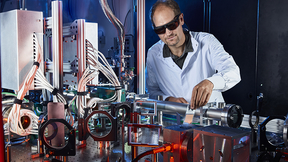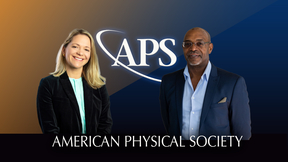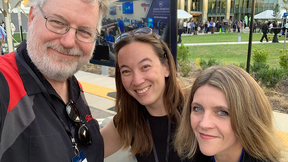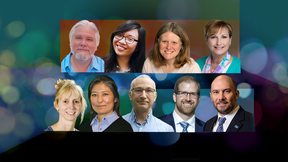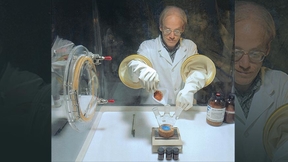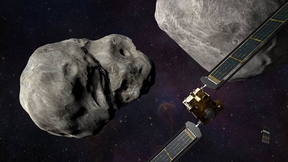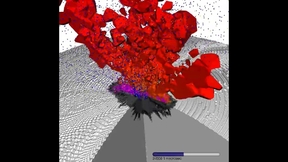Back
Electromagnetic vortices occur naturally throughout the universe and have recently been observed in association with black holes. Over the last decade, scientists have sought methods to investigate how extremely strong electromagnetic vortices interact with matter, specifically plasma, in a laboratory setting. Plasma, known as the “fourth state of matter,” makes up nearly…
The United Nations (UN) Intergovernmental Panel on Climate Change (IPCC) was jointly awarded the Gulbenkian Prize for Humanity, alongside the Intergovernmental Science-Policy Platform on Biodiversity and Ecosystem Services (IPBES). The prize jury distinguished the two intergovernmental organizations for their role in developing scientific knowledge, alerting society and…
Two Lawrence Livermore National Laboratory (LLNL) scientists have been selected as 2022 fellows of the American Physical Society (APS). Physicists Andrea (Annie) Kritcher and Ronnie Shepherd were both selected by the APS Division of Plasma Physics. APS fellowships are awarded after extensive review and are considered a distinct honor because the evaluation process,…
Lawrence Livermore National Laboratory (LLNL) empowers multidisciplinary teams to pursue bold and innovative science and technology, finding solutions to some of the greatest security challenges facing the nation and the world — and the Lab is growing every day. To recruit prospective employees for more than 500 open positions, LLNL is hosting its first-ever on-site career…
Safe, long-cycle-life batteries with high energy density are greatly needed with the rapid growth of electric devices and vehicles and grid energy storage demands. Lawrence Livermore National Laboratory (LLNL) scientists have devised a method for the fabrication of all-solid-state lithium metal batteries, which have been recognized as the future choice of safe and high…
On Tuesday, Oct. 11, more than 5,000 Lawrence Livermore National Laboratory (LLNL) employees gathered to celebrate the Lab’s 70th anniversary. Throughout the first-ever Employee Engagement Day, dozens of the Lab’s facilities and programs opened their doors for employees to get a close-up look at LLNL’s cutting-edge science and technology. It was a celebration of making the…
It was a scene right out of the movies. NASA’s DART spacecraft successfully impacted its asteroid target in the world’s first planetary defense technology demonstration at 4:14 p.m. (PDT) on Sept. 26. Two weeks after impact, NASA has confirmed the mission changed the asteroid’s motion in space. “We were anxiously awaiting the spacecraft’s final hours with the DART…
Lawrence Livermore National Laboratory (LLNL) research scientist Richard Kraus is the recipient of the inaugural American Physical Society’s 2023 Neil Ashcroft Early Career Award for Studies of Matter at Extreme High Pressure Conditions. Kraus is recognized for his outstanding theoretical or experimental contributions by an early-career scientist to studies of matter at…
John Clauser, an experimental physicist who spent a decade at Lawrence Livermore National Laboratory (LLNL), has been awarded the 2022 Nobel Prize in Physics, along with French scientist Alain Aspect and Austrian scientist Anton Zeilinger. The Nobel Committee, made up of members from the Royal Swedish Academy of Sciences, cited the trio for “experiments with entangled…
The Earth System Grid Federation (ESGF), an international multi-institutional initiative that gathers and distributes data for top-tier computer simulations of the Earth’s climate, is preparing a series of upgrades that will make using the data easier and faster while improving how the information is curated. A new project called ESGF2, encapsulates the primary U.S…
The three-building Hertz Hall complex on the east side of Lawrence Livermore National Laboratory (LLNL) has a new look and a new name. Following an extensive nine-month renovation, the buildings now form the University of California Livermore Collaboration Center (UCLCC) and will serve as a University of California (UC) multi-campus hub to expand collaborations and…
Physicist Tom Ramos has had several roles for the past 40 years at Lawrence Livermore National Laboratory. He served as a member of the nuclear team that developed the X-ray laser for President Reagan’s Strategic Defense Initiative, he supported United States arms control negotiations for START, and over a span of seventeen years he created and ran a program for the…
It could be called better understanding through chemistry. An international research team including Lawrence Livermore National Laboratory (LLNL) scientists has succeeded in gaining new insights into the chemical properties of the superheavy element flerovium — element 114. The measurements, taken at the at the accelerator facilities of the GSI Helmholtzzentrum für…
The last nuclear test, code-named Divider, took place 30 years ago, on Sept. 23, 1992. That year, President Bush declared a temporary moratorium on nuclear testing, which became permanent during the Clinton administration. This ending of the era of nuclear testing was also the beginning of stockpile stewardship. Leaders from the Department of Energy (DOE), and Lawrence…
Scientific discovery during the Stockpile Stewardship Program maintains confidence in the nuclear deterrent without testing, brings other benefits The last nuclear test, code-named Divider, took place 30 years ago, on September 23, 1992. That year, President Bush declared a temporary moratorium on nuclear testing, which became permanent during the Clinton administration…
The last nuclear test, code-named Divider, took place 30 years ago, on Sept. 23, 1992. That year, President Bush declared a temporary moratorium on nuclear testing, which became permanent in 1995, during the Clinton administration. This ending of the era of nuclear testing coincided with a Presidential announcement of the beginning of stockpile stewardship. As the decision…
Today at 4:14 p.m. (PDT), NASA’s Double Asteroid Redirection Test (DART) Mission will execute the first-ever asteroid-deflection test by crashing into asteroid Dimorphos. Traveling at ~6 km/s with a mass of ~600 kg, the DART spacecraft will transfer enough momentum for the imparted change in velocity to be detectable from Earth-based telescopes. However, there is…
An international team including a researcher from Lawrence Livermore National Laboratory (LLNL) has determined that one specific particle on the asteroid Ryugu can shed light on the unaltered initial materials from its parent body. In December 2014, the Japanese Aerospace Exploration Agency launched the spacecraft Hayabusa2 to the asteroid 162173 Ryugu. In December 2020,…
NASA’s Double Asteroid Redirection Test (DART) spacecraft will crash into asteroid Dimorphos on Sept. 26, executing the first asteroid deflection test that has been years in the planning. Dimorphos, at 150 meters across, is the “moonlet” of a binary asteroid system, orbiting the larger companion asteroid, Didymos (800 meters). The momentum of the ~600 kg spacecraft,…
Steven Bohlen has been named as the senior director for Lawrence Livermore National Laboratory’s Office of Government and External Affairs (OGEA), Director Kimberly Budil announced today. His appointment is effective Sept. 18. In this new role, Bohlen will partner with the Senior Management Team (SMT) to develop and manage strong and productive relationships between the…

